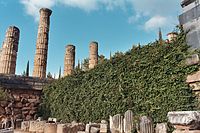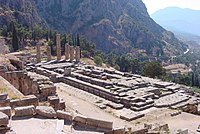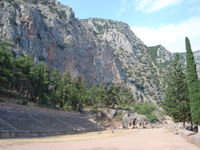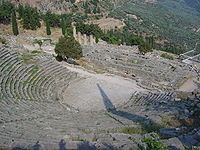Delphi
From Wikipedia, the free encyclopedia
| Archaeological Site of Delphi* | |
|---|---|
| UNESCO World Heritage Site | |
 |
|
| Type | Cultural |
| Criteria | i, ii, iii, iv, vi |
| Reference | 393 |
| Region** | Europe |
| Inscription history | |
| Inscription | 1987 (11th Session) |
| * Name as inscribed on World Heritage List. ** Region as classified by UNESCO. |
|
Delphi (Greek Δελφοί, [ðe̞lˈfi]) (pronounce[1] and dialectal forms [2]) is an archaeological site and a modern town in Greece on the south-western spur of Mount Parnassus in the valley of Phocis. Delphi was the site of the Delphic oracle, the most important oracle in the classical Greek world, when it was a major site for the worship of the god Apollo after he slew the Python, a deity who lived there and protected the navel of the Earth. His sacred precinct in Delphi was a panhellenic sanctuary, where every four years athletes from all over the Greek world competed in the Pythian Games, one of the four panhellenic (or stephanitic) games, precursors to the Modern Olympics.
Delphi was revered throughout the Greek world as the site of the omphalos stone, the centre of the earth and the universe. In the inner hestia ("hearth") of the Temple of Apollo, an eternal flame burned. After the battle of Plataea, the Greek cities extinguished their fires and brought new fire from the hearth of Greece, at Delphi; in the foundation stories of several Greek colonies, the founding colonists were first dedicated at Delphi.[3]
Contents |
[edit] Location
Delphi site is located in lower central Greece, on multiple plateau/terraces along the slope of Mount Parnassus, and includes the Sanctuary of Apollo, the site of the ancient Oracle. This semicircular spur is known as Phaedriades, and overlooks the Pleistos Valley. Southwest of Delphi, about 15 km (9.5 mi) away, is the harbor-city of Kirrha on the Corinthian Gulf.
[edit] Dedication to Apollo
The name Delphois starts with the same four letters as δελφύς delphus, "womb" and may indicate archaic veneration of Gaia, Grandmother Earth, and the Earth Goddess at the site. [4][5] Apollo is connected with the site by his epithet Δελφίνιος Delphinios, "the Delphinian." The epithet is connected with dolphins (Greek δελφίς,-ῖνος) in the Homeric Hymn to Apollo (line 400), recounting the legend of how Apollo first came to Delphi in the shape of a dolphin, carrying Cretan priests on his back. The Homeric name of the oracle is Pytho (Πυθώ).[6]
Another legend held that Apollo walked to Delphi from the north and stopped at Tempe, a city in Thessaly to pick laurel, a plant sacred to him (generally known in English as the bay tree). In commemoration of this legend, the winners at the Pythian Games received a wreath of laurel (bay leaves) picked in Tempe.
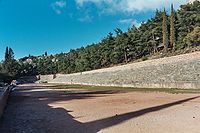
Delphi became the site of a major temple to Phoebus Apollo, as well as the Pythian Games and the famous prehistoric oracle. Even in Roman times, hundreds of votive statues remained, described by Pliny the Younger and seen by Pausanias. Supposedly carved into the temple were three phrases: γνωθι σεαυτόν (gnothi seauton = "know thyself") and μηδέν άγαν (meden agan = "nothing in excess"), and Εγγύα πάρα δ'ατη (eggua para d'atē = "make a pledge and mischief is nigh"),[7] as well as a large letter E.[8] Among other things epsilon signifies the number 5. Plutarch's essay on the meaning of the “E at Delphi" is the only literary source for the inscription. In ancient times, the origin of these phrases was attributed to one or more of the Seven Sages of Greece,[9] though ancient as well as modern scholars have doubted the legitimacy of such ascriptions.[10] According to one pair of scholars, "The actual authorship of the three maxims set up on the Delphian temple may be left uncertain. Most likely they were popular proverbs, which tended later to be attributed to particular sages."[11]
From a late myth that deviates from much older ones, when young, Apollo killed the chthonic serpent Python, named Pythia in older myths, but according to some later accounts his wife, Pythia, who lived beside the Castalian Spring, according to some because Python had attempted to rape Leto while she was pregnant with Apollo and Artemis. The bodies of the pair were draped around his Rod, which, with the wings created the caduceus symbolic of the god. This spring flowed toward the temple but disappeared beneath, creating a cleft which emitted vapors that caused the Oracle at Delphi to give her prophecies. Apollo killed Python but had to be punished for it, since she was a child of Gaia. The shrine dedicated to Apollo was originally dedicated to Gaia and then, possibly to Poseidon. The name Pythia remained as the title of the Delphic Oracle. As punishment for this murder Apollo was sent to serve in menial tasks for eight years. A festival, the Septeria, was performed annually portraying the slaying of the serpent, the flight, the atonement and the return of the God. The Pythian Games took place every four years to commemorate his victory[12].
Erwin Rohde wrote that the Python was an earth spirit, who was conquered by Apollo, and buried under the Omphalos, and that it is a case of one deity setting up a temple on the grave of another.[13] Another view holds that Apollo was a fairly recent addition to the Greek pantheon coming originally from Lydia. The Etruscans coming from northern Anatolia also worshiped Apollo, and it may be that he was originally identical with Mesopotamian Aplu, an Akkadian title meaning "son", originally given to the plague God Nergal, son of Enlil. Apollo Smintheus (Greek Απόλλων Σμινθεύς), the mouse killer[14] eliminates mice, a primary cause of disease, hence he promotes preventive medicine.
[edit] Oracle
Delphi is perhaps best-known for the oracle at the sanctuary that became dedicated to Apollo during the classical period. According to Aeschylus in the prologue of the Eumenides, it had origins in prehistoric times and the worship of Gaia. In the last quarter of the 8th century BCE there is a steady increase of artifacts found at the settlement site in Delphi. Pottery and bronze work as well as tripod dedications continue in a steady stream, in comparison to Olympia. Neither the range of objects nor the presence of prestigious dedications proves that Delphi was a focus of attention for worshipers of a wide range, but the strong representation of high value goods, found in no other mainland sanctuary, certainly encourages that view.
The priestess of the oracle at Delphi was known as the Pythia. Apollo spoke through his oracle, who had to be an older woman of blameless life chosen from among the peasants of the area. The sibyl or prophetess took the name Pythia and sat on a tripod seat over an opening in the earth. When Apollo slew Python, its body fell into this fissure, according to legend, and fumes arose from its decomposing body. Intoxicated by the vapors, the sibyl would fall into a trance, allowing Apollo to possess her spirit. In this state she prophesied. It has been postulated that a gas came out of this opening that is known to produce violent trances, though this theory remains debatable.[15] While in a trance the Pythia "raved" - probably a form of ecstatic speech - and her ravings were "translated" by the priests of the temple into elegant hexameters. People consulted the Delphic oracle on everything from important matters of public policy to personal affairs.
H.W. Parke writes that the foundation of Delphi and its oracle took place before the times of recorded history and its origins are obscure, but dating to the worship of the Great Goddess, Gaia.[16]
The Oracle exerted considerable influence throughout the Greek world, and she was consulted before all major undertakings: wars, the founding of colonies, and so forth. She also was respected by the semi-Hellenic countries around the Greek world, such as Lydia, Caria, and even Egypt.
- For a list of some of the most noted oracular pronouncements of the Pythia, go to Famous Oracular Statements from Delphi.
The Oracle benefited by the Macedonian Kings. Later it was placed under the protection of the Aetolians. After a brief period the Romans started to emerge, who even protected it from a dangerous barbarian invasion in 109 B.C. and 105 B.C. A major reorganization was initiated which was interrupted by the wars of Mithridatic Wars and Sulla who took many rich offerings from the Oracle. Barbarian invasions were the direct cause of harm, burning the Temple, which was damaged severely by the earthquake in 83 B.C. Ever since the Oracle fell in decay and the whole area in great poverty. The small population led to difficulties in finding the right people to fill the posts required. Its credibility waned due to doubtful predictions. When Nero came to Greece in 66 AD, he took away over 500 of the best statues from Delphi to Rome. Subsequent Roman emperors from the Flavian dynasty contributed significantly towards its restoration. Hadrian offered complete autonomy. Also Plutarch was a significant factor by his presence as a chief priest. However, barbarian raids during the reign of Marcus Aurelius and removal of statues and other riches (practically looting) by Constantine the Great caused it to decay. The short reign of Julian the Apostate was not capable to improve its situation. Despite this, the Oracle existed until it was ordered to close by emperor Theodosius I in 395 AD. The site was abandoned for almost 100 years, until Christians started to settle permanently in the area and established a small town about 600 AD by the name Kastri.
[edit] The "Delphic Sibyl"
The Delphic Sibyl was a legendary prophetic figure who was said to have given prophecies at Delphi shortly after the Trojan War. The prophecies attributed to her circulated in written collections of prophetic sayings, along with the oracles of figures such as Bakis. The Sibyl had no connection to the oracle of Apollo, and should not be confused with the Pythia.
[edit] Buildings and structures
Occupation of the site at Delphi can be traced back to the Neolithic period with extensive occupation and use beginning in the Mycenaean period (1600-1100 B.C). Most of the ruins that survive today date from the most intense period of activity at the site in the 6th century BC.[17]
[edit] Temple of Apollo
The ruins of the Temple of Delphi visible today date from the 4th century BC are of a peripteral Doric building. It was erected on the remains of an earlier temple, dated to the 6th century BC which itself was erected on the site of a 7th century BC construction attributed to the architects Trophonios and Agamedes.[18]
The 6th century BC temple was named the "Temple of Alcmeonidae" in tribute to the Athenian family which funded its construction. It was a Doric hexastyle temple of 6 by 15 columns. The temple was destroyed in 373 BC by an earthquake with the third temple completed on the site by 330 BC. The third temple is attributed to Corinthian architects Spintharos, Xenodoros, and Agathon.[19]
The pediment sculptures are a tribute to Praxias and Androsthenes of Athens. Of a similar proportion to the second temple it retained the 6 by 15 column pattern around the stylobate.[19] Inside was the adyton, the centre of the Delphic oracle and seat of Pythia. The monument was partly restored during 1938-1941.
[edit] Treasuries
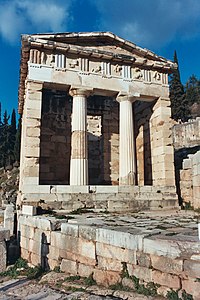
From the entrance of the site, continuing up the slope almost to the temple itself, are a large number of votive statues, and numerous treasuries. These were built by the various Greek city states — those overseas as well as those on the mainland — to commemorate victories and to thank the oracle for her advice, which was thought to have contributed to those victories. They are called "treasuries" because they held the offerings made to Apollo; these were frequently a "tithe" or tenth of the spoils of a battle. The most impressive is the now-restored Athenian Treasury, built to commemorate the Athenians' victory at the Battle of Salamis. According to Pausanias, the Athenians had previously been given the advice by the oracle to put their faith in their "wooden walls" — taking this advice to mean their navy, they won a famous battle at Salamis. Several of the treasuries can be identified, among them the Siphnian Treasury, dedicated by the city of Siphnos whose citizens gave a tithe of the yield from their gold mines until the mines came to an abrupt end when the sea flooded the workings.
Other identifiable treasuries are those of the Sikyonians, the Boetians and the Thebans. One of the largest of the treasuries was that of Argos. Built in the late Doric period, the Argives took great pride in establishing their place amongst the other city states. Completed in the year 380, the treasury draws inspiration mostly from the Temple of Hera located in the Argolis, the acropolis of the city. However, recent analysis of the Archaic elements of the treasury suggest that its founding preceded this.
As a result of these treasuries, through the protection of the Amphictyonic League, Delphi came to function as the de-facto Central Bank of Ancient Greece. It was the abuse of these treasuries by Philip of Macedon and the later sacking of the Treasuries, first by the Celts, and later by Sulla, the Roman Dictator, that led to the eclipse of Greek civilization and the eventual growth of Rome.
[edit] Altar of the Chians
Located in front of the Temple of Apollo, the main altar of the sanctuary was paid for and built by the people of Chios. It is dated to the 5th century BC by the inscription on its cornice. Made entirely of black marble, except for the base and cornice, the altar would have made a striking impression. It was restored in 1920.[20]
[edit] Stoa of the Athenians
The stoa leads off north-east from the main sanctuary. It was built in the Ionic order and consists of seven fluted columns, unusually carved from single pieces of stone (most columns were constructed from a series of discs joined together). The inscription on the stylobate indicates that it was built by the Athenians after their naval victory over the Persians in 478 BC, to house their war trophies.[20] The rear wall of the stoa contains nearly a thousand inscriptions; supposedly any slave manumitted in Athens was obliged to record a short biography here, explaining why he had deserved his freedom.
[edit] Polygonal wall
The retaining wall was built to support the terrace housing the construction of the second temple of Apollo in 548 BC. Its name is taken from the polygonal masonry of which it is constructed.[20]
[edit] Gymnasium
The gymnasium, which is half a mile away from the main sanctuary, was a series of buildings used by the youth of Delphi. The building consisted of two levels: a stoa on the upper level providing open space, and a palaestra, pool and baths on lower floor. These pools and baths were said to have magical powers, and imparted the ability to communicate to Apollo himself.[20]
[edit] Castalian spring
The sacred spring of Delphi lies in the ravine of the Phaedriades. The preserved remains of two monumental fountains that received the water from the spring date to the Archaic period and the Roman, with the later cut into the rock.
[edit] Stadium
The stadium is located further up the hill, beyond the via sacra and the theatre. It was originally built in the 5th century BC but was altered in later centuries. The last major remodeling took place in the 2nd century AD under the patronage of Herodus Atticus when the stone seating was built and (arched) entrance. It could seat 6500 spectators and the track was 177 metres long and 25.5 metres wide.[21]
[edit] Theatre
The ancient theatre at Delphi was built further up the hill from the Temple of Apollo giving spectators a view of the entire sanctuary and the valley below. It was originally built in the 4th century BC but was remodeled on several occasions since. Its 35 rows can seat 5,000 spectators.[19]
[edit] Tholos
The Tholos at the sanctuary of Athena Pronaia is a circular building that was constructed between 380 and 360 BC. It consisted of 20 Doric columns arranged with an exterior diameter of 14.76 meters, with 10 Corinthian columns in the interior.
The Tholos is located approximately a half-mile (800 m) from the main ruins at Delphi. Three of the Doric columns have been restored, making it the most popular site at Delphi for tourists to take photographs.
Vitruvius (vii, introduction) notes Theodorus the Phocian as the architect of the Round Building which is at Delphi.
[edit] Sibyl rock
The Sibyl rock is a pulpit-like outcrop of rock between the Athenian Treasury and the stoa of the Athenians upon the sacred way which leads up to the temple of Apollo in the archaeological area of Delphi. It is claimed to be where the Sibyl sat to deliver her prophecies.
[edit] Excavations
The site had been occupied by the village of Kastri since medieval times and this had to be relocated before a systematic excavation of the site could be undertaken, a relocation resisted by the residents. The opportunity to relocate the village was presented when it was substantially damaged by an earthquake, with villagers offered a completely new village in exchange for the old site. In 1893 the French Archaeological School removed vast quantities of soil from numerous landslides to reveal both the major buildings and structures of the sanctuary of Apollo and of Athena Proaea along with thousands of objects, inscriptions and sculptures.[20]
[edit] Architecture
The complex architecture of the sanctuary and the temple were part of Doric and Corinthian order, which was passed down from generations by Spintharus, who was notable for rebuilding the temple of Apollo in 373BC.
Four areas of the site have been reconstructed to greater of lesser extents. The Treasury of the Athenians was fully reconstructed from its original materials by the original French excavation team under the sponsorship of the Mayor of Athens. The Altar of the Chians was reconstructed in 1959 by the Greek Archaeological Services. The Tholos and Temple of Apollo have been subject to limited reconstructions.[20]
[edit] Modern Delphi
Modern Delphi is situated immediately west of the archaeological site and hence is a popular tourist destination. It is on a major highway linking Amfissa along with Itea and Arachova. There are many hotels and guest houses in the town, and many taverns and bars. The main streets are narrow, and often one-way. Delphi also has a school, a lyceum, a church and a square (plateia). The Trans European Footpath E4 passes through the east end of the town. In addition to the archaeological interest, Delphi attracts tourists visiting the Parnassus Ski Center and the popular coastal towns of the region. The town has a population of 2,373 people while the population of the municipality of Delphi, including Chrisso (ancient Krissa), is 3,511.
In medieval times Delphi was also called Kastri and was built on the archaeological site. The residents had used the marble columns and structures as support beams and roofs for their improvised houses, a usual way of rebuilding towns which were partially or totally destroyed, especially after the earthquake in 1580 which demolished several towns in Phocis. In 1893 archaeologists from the École française d'Athènes finally located the actual site[22] of ancient Delphi and the village was moved to a new location, west of the site of the temples.
The Delphi Archaeological Museum is at the foot of the main archaeological complex, on the east side of the village, and on the north side of the main road. The museum houses an impressive collection associated with ancient Delphi, including the earliest known notation of a melody, the famous Charioteer, golden treasures discovered beneath the Sacred Way, and fragments of reliefs from the Siphnian Treasury. Immediately adjacent to the exit (and overlooked by most tour guides) is the inscription which mentions the Roman proconsul Gallio.
Entries to the museum and to the main complex are separate and chargeable, and a reduced rate ticket gets entry to both. There is a small cafe, and a post office by the museum. Slightly further east, on the south side of the main road, is the Gymnasium and the Tholos. Entry to these is free.
[edit] Media
[edit] See also
- Greek art
- List of traditional Greek place names
- Aristoclea - Delphic priestess of the 6th Century B.C., said to have been tutor to Pythagoras
- Delphi Archaeological Museum
[edit] Notes
- ^ The name Delphi is pronounced, in the English manner, as "Delf-eye" or in the Greek manner, as "Delfee" depending on regional accent. The Greek spelling transliterates as "Delphoi" (with "o" added).
- ^ Belphoi - Aeolian form, Dalphoi - Phocian form and other Greek dialectal varieties
- ^ Burkert 1985, pp. 61, 84.
- ^ Fontenrose, Joseph, The Delphic Oracle: Its Responses and Operations, with a Catalogue of Responses (1978). pp.3-4. "Such was its prestige that most Hellenes after 500 B.C. placed its foundation in the earliest days of the world: before Apollo took possession, they said, Ge (Earth) [Gaia] and her daughter Themis had spoken oracles at Pytho. Such has been the strength of the tradition that many historians and others have accepted as historical fact the ancient statement that Ge and Themis spoke oracles before it became Apollo's establishment. Yet nothing but the myth supports this statement. In the earliest account that we have of the Delphic Oracle's beginnings, the story found in the Homeric Hymn to Apollo (281-374), there was no Oracle before Apollo came and killed the great she-dragon, Pytho's only inhabitant. This was apparently the Delphic myth of the sixth century".
- ^ Farnell, Lewis Richard, The Cults of the Greek States, v.III, pp.8-10, onwards. "The earth is the abode of the dead, therefore the earth-deity has power over the ghostly world : the shapes of dreams, which often foreshadowed the future, were supposed to ascend from the world below, therefore the earth-deity might acquire an oracular function, especially through the process of incubation, in which the consultant slept in a holy shrine with his ear upon the ground. That such conceptions attached to Gaia is shown by the records of her cults at Delphi, Athens, and Aegae. A recently discovered inscription speaks of a temple of Ge [Gaia] at Delphi. ... As regards Gaia, we also can accept it. It is confirmed by certain features in the latter Delphic divination, and also by the story of the Python."
- ^ Odyssey, VIII, 80
- ^ Plato, Charmides 164d-165a.
- ^ Hodge, A. Trevor. "The Mystery of Apollo's E at Delphi," American Journal of Archaeology, Vol. 85, No. 1. (Jan., 1981), pp. 83-84.
- ^ Plato, Protagoras 343a-b.
- ^ H. Parke and D. Wormell, The Delphic Oracle, (Basil Blackwell, 1956), vol. 1, pp. 387-389.
- ^ Parke & Wormell, p. 389.
- ^ Cf. Seyffert, Dictionary of Classic Antiquities, article on "Delphic Oracle"
- ^ Rodhe, E (1925), "Psyche: The Cult of Souls and the Belief in Immortality among the Greeks", trans. from the 8th edn. by W. B. Hillis (London: Routledge & Kegan Paul, 1925; reprinted by Routledge, 2000). p.97.
- ^ Entry: σμινθεύς at Henry George Liddell, Robert Scott, A Greek-English Lexicon
- ^ See Spiller, Hale, and de Boer.
- ^ Herbert William Parke, The Delphic Oracle, v.1, p.3. "The foundation of Delphi and its oracle took place before the times of recorded history. It would be foolish to look for a clear statement of origin from any ancient authority, but one might hope for a plain account of the primitive traditions. Actually this is not what we find. The foundation of the oracle is described by three early writers: the author of the Homeric Hymn to Apollo, Aeschylus in the prologue to the Eumenides, and Euripides in a chorus in the Iphigeneia in Tauris. All three versions, instead of being simple and traditional, are already selective and tendentious. They disagree with each other basically, but have been superficially combined in the conventional version of late classical times." Parke goes on to say, "This version [Euripides] evidently reproduces in a sophisticated form the primitive tradition which Aeschylus for his own purposes had been at pains to contradict: the belief that Apollo came to Delphi as an invader and appropriated for himself a previously existing oracle of Earth. The slaying of the serpent is the act of conquest which secures his possession; not as in the Homeric Hymn, a merely secondary work of improvement on the site. Another difference is also noticeable. The Homeric Hymn, as we saw, implied that the method of prophecy used there was similar to that of Dodona: both Aeschylus and Euripides, writing in the fifth century, attribute to primeval times the same methods as used at Delphi in their own day. So much is implied by their allusions to tripods and prophetic seats." Continuing on p.6, "Another very archaic feature at Delphi also confirms the ancient associations of the place with the Earth goddess. This was the Omphalos, an egg-shaped stone which was situated in the innermost sanctuary of the temple in historic times. Classical legend asserted that it marked the 'navel' (Omphalos) or centre of the Earth and explained that this spot was determined by Zeus who had released two eagles to fly from opposite sides of the earth and that they had met exactly over this place". On p.7 he writes further, "So Delphi was originally devoted to the worship of the Earth goddess whom the Greeks called Ge, or Gaia (mythology). Themis, who is associated with her in tradition as her daughter and partner or successor, is really another manifestation of the same deity: an identity which Aeschylus himself recognized in another context. The worship of these two, as one or distinguished, was displaced by the introduction of Apollo. His origin has been the subject of much learned controversy: it is sufficient for our purpose to take him as the Homeric Hymn represents him -- a northern intruder -- and his arrival must have occurred in the dark interval between Mycenaean and Hellenic times. His conflict with Ge for the possession of the cult site was represented under the legend of his slaying the serpent."
- ^ Delphi Archaeological Site, Ancient-Greece.org
- ^ Temple of Apollo at Delphi, Ancient-Greece.org
- ^ a b c Delphi Theater at Ancient-Greece.org.
- ^ a b c d e f Delphi, Hellenic Ministry of Culture.
- ^ Delphi Stadium at Ancient-Greece.org.
- ^ (see link)
[edit] References
- Broad, William J. The Oracle: Ancient Delphi and the Science Behind its Lost Secrets, 2006. ISBN 1-59-420081-5.
- Burkert, Walter, Greek Religion 1985.
- Connelly, Joan Breton, Portrait of a Priestess: Women and Ritual in Ancient Greece, Princeton University Press, 2007. ISBN 0691127468
- Dempsey, T., Reverend, The Delphic oracle, its early history, influence and fall, Oxford : B.H. Blackwell, 1918.
- Farnell, Lewis Richard, The Cults of the Greek States, in five volumes, Clarendon Press, 1896-1909. (Cf. especially, volume III and volume IV on the Pythoness and Delphi).
- Fontenrose, Joseph Eddy, The Delphic oracle, its responses and operations, with a catalogue of responses, Berkeley : University of California Press, 1978. ISBN 0520033604
- Fontenrose, Joseph Eddy, Python; a study of Delphic myth and its origins, New York, Biblio & Tannen, 1974. ISBN 081960285X
- Goodrich, Norma Lorre, Priestesses, New York : F. Watts, 1989. ISBN 0531151131
- Guthrie, William Keith Chambers, The Greeks and their Gods, 1955.
- Hall, Manly Palmer, The Secret Teachings of All Ages, 1928. Ch. 14 cf. Greek Oracles,www, PRS
- Herodotus, The Histories
- Homeric Hymn to Pythian Apollo
- Manas, John Helen, Divination, ancient and modern, New York, Pythagorean Society, 1947.
- Parke, Herbert William, History of the Delphic Oracle, 1939.
- Plutarch "Lives"
- Rohde, Erwin, Psyche, 1925.
- Seyffert, Oskar, "Dictionary of Classical Antiquities", London : W. Glaisher, 1895.
- Spiller, Henry A., John R. Hale, and Jelle Z. de Boer. "The Delphic Oracle: A Multidisciplinary Defense of the Gaseous Vent Theory." Clinical Toxicology 40.2 (2000) 189-196.
- West, Martin Litchfield, The Orphic Poems, 1983. ISBN 0-19-814854-2.
[edit] Further reading
- Morgan, Catherine, Athletes and Oracles: The Transformation of Olympia and Delphi in the Eighth Century BC, Cambridge [England] ; New York : Cambridge University Press, 1990. ISBN 0521374510
[edit] External links
| Wikimedia Commons has media related to: Delphi |
[edit] General
- Official website of the archaeological site
- Official website of the Museum
- History of the Ecole française d'Athènes in Delphi (French)
- Homepage of the modern municipality (English) (Greek)
- Hellenic Ministry of Culture: Delphi
- Delphi (Greek)
- C. Osborne, "A Short detour to Delphi and the Sibyls"
- Livius Picture Archive: Delphi
- Eloise Hart, "The Delphic oracle"
- III JUNIOR DELPHIC GAMES 2007 Baguio City, Philippines - November 10 to 15
- International Delphic Council
- ASHES2ART Digital Delphi
[edit] Geology of Delphi
- John R. Hale, et al., "Questioning the Delphic Oracle: When science meets religion at this ancient Greek site, the two turn out to be on better terms than scholars had originally thought", in Scientific American August 2003
- John Roach, "Delphic Oracle's Lips May Have Been Loosened by Gas Vapors" in National Geographic news, August 2001
- Geology of Delphi
- The New York Times, March 19, 2002: "Fumes and Visions Were Not a Myth for Oracle at Delphi"
- A Geological Companion to Greece and the Aegean by Michael and Reynold Higgins, Cornell University Press, 1996
|
|||||||||||||||||||||||||||||||
|
|||||||
|
|||||

